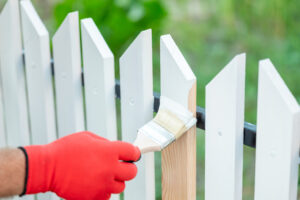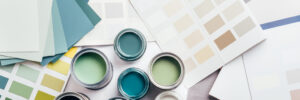
Best Paint for Trim and Baseboards
Baseboards and trim can elevate the appearance of your home’s interior, but even the most ornate trim piece will look dilapidated if it is not
Painting baseboards can be tricky – there’s often multiple surfaces, you have to contend with tight corners and edges, and you need to be precise with your strokes. Choosing the right paint brush can be the difference between a straightforward project and a complicated mess, but with all of the options available you may not know which one to choose.
With this guide you’ll learn which is the best paint brush for baseboards, and why the brush you choose for your project makes such a big difference.

You may pick out the best handle and brush style for your job, but if you don’t pay attention to the bristle type you may still not have the best paint brush. For water-based paints like latex paint, you are going to want a brush with nylon or poly-nylon (polyester and nylon blend) bristles. For oil-based paints, natural bristle brushes give the best results.
While you can use a synthetic bristle type with oil-based paints, natural bristles tend to give cleaner lines and less streaks. It is not recommended to use natural bristles with water-based paints at all, however, as the bristles will absorb the paint and not keep their shape. You will also want to use a sash brush for baseboards and trim projects. Sash brushes have a lower bristle count than wall brushes, which means that they hold less paint at a time. This ultimately gives you more control over the paint lines, which is ideal for working on smaller and more precise projects like baseboards.
As with any paint brush, you do not want to reach for the cheapest option on the shelf. A low-quality brush will have bristles that are more easily displaced, be more prone to streaking, and will ultimately cost you more in frustration than getting a high-quality brush to start.

Baseboards come in a variety of materials, profiles, and sizes. The most common material for baseboards in the home is MDF (medium density fiberboard) or hardwood, and the most common profile is stepped/rounded. While the baseboard material will not likely affect your paint brush selection, the profile and size may come into play. Here are our votes for the best paint brushes based on the different types of baseboards:
As mentioned, this is the most common profile for a baseboard that you will find in the home, and it is most often found in the 3 to 3.5-inch size. This baseboard gives a clean and elegant appearance to any room, but the curved top and decorative grooves can make it a little daunting to paint. For this type of baseboard, you will want to use a 2-inch angled sash brush. Some people prefer a 2.5-inch brush for this baseboard size, but you will have more control with a shorter brush width. The angled cut on the bristles will allow you to achieve straighter lines and also assists with the tight corners and sharp angles that often accompany baseboards.
The brush handle is more a matter of personal preference than performance. Short-handled brushes tend to allow for maximum control of the brush. Square handles are also commonly featured in trim brushes, and provide greater comfort. The best paint brush for a stepped baseboard, therefore, is a 2-inch angled brush with a short or square handle, and the bristle type that matches your paint. Purdy and Wooster are both trusted brands, and both offer these styles of paint brushes.
Baseboards with a flat profile do not have any of the curves or grooves of the stepped profile, creating a simple yet finished look to any home or workplace. The height for a flat baseboard generally ranges from 3.5 inches to 4.5 inches. With this baseboard, the size of the brush you want depends on the height of the board. For a smaller height, the 2-inch brush is still recommended. With a taller height, however, you may find it easier to use a 2.5-inch brush. You may be tempted to reach for a flat paintbrush to match your flat baseboards, since they don’t have the same protruding features as the stepped profile. It is still best to use an angled brush for this baseboard, however, because there will still be tight corners that you need to get into easily and the angled brush delivers as sharp of lines as the flat brush. The same principles for the bristle type and the handle type apply for the flat baseboard profile as for the stepped, but you may find it more comfortable to have a longer-handled brush if your baseboards are taller. Some people will use a 4-inch mini roller to more efficiently paint flat baseboards, and this is the only baseboard style that a roller would be useful with. Even if you go this route you are still going to need a paint brush to get in the corners, and a brush is always going to give you sharper lines than a roller. The best paint brush for a flat baseboard, therefore, is a 2-inch angled sash brush with a short or square handle for shorter baseboards, and a 2.5-inch angled sash brush with a square handle for taller baseboards. Ensure your bristle type matches your paint, and both Purdy and Wooster offer these paint brushes.
Like the stepped profile, these baseboards have more detailed scallops and grooves for a decorative finish. Despite the similar design, the height of these baseboards tend to be much taller – starting at 4 inches and going up to 7 inches or even taller. These baseboards are generally used in larger homes with more luxurious interior design. For this baseboard type, it may be tempting to reach for a larger brush since you have more surface area to cover. A 3-inch angled sash brush is going to allow you to work faster, but you are still going to have greater precision with a 2.5-inch brush. If you are an experienced painter you will likely achieve the same results with a larger brush. For those just starting out, you may consider the smaller brush even though it will take a bit longer. A roller is not likely to save you much time with these baseboards due to their intricate designs at the top. You will also likely be most comfortable with a long, square handle for your paint brush, and make sure you consider the best bristle type for your paint.
The best paint brush for a sculpted baseboard, therefore, is a 2.5 or 3-inch angled sash brush with a square handle, and the bristle type that matches your paint. Wooster and Purdy also offer these brushes. Painting baseboards may seem like an intimidating project, but the right tool will make it much easier. The best paint brush for baseboards will ultimately depend on the type of baseboard you have and the type of paint you’re using. Regardless, a high-quality brush is always more likely to produce high-quality results.

Baseboards and trim can elevate the appearance of your home’s interior, but even the most ornate trim piece will look dilapidated if it is not

You’ve just installed your beautiful new fence! Now, while it cures, you have the difficult decision of choosing a stain or paint color. With all

How to Find the Right Color for Your Interior Paint Job Have you procrastinated painting the walls in your home because you’re worried you won’t

Baseboards and trim can elevate the appearance of your home’s interior, but even the most ornate trim piece will look dilapidated if it is not

You’ve just installed your beautiful new fence! Now, while it cures, you have the difficult decision of choosing a stain or paint color. With all